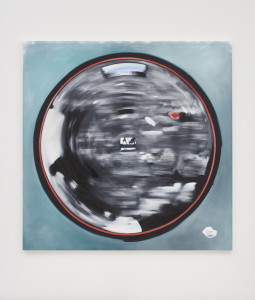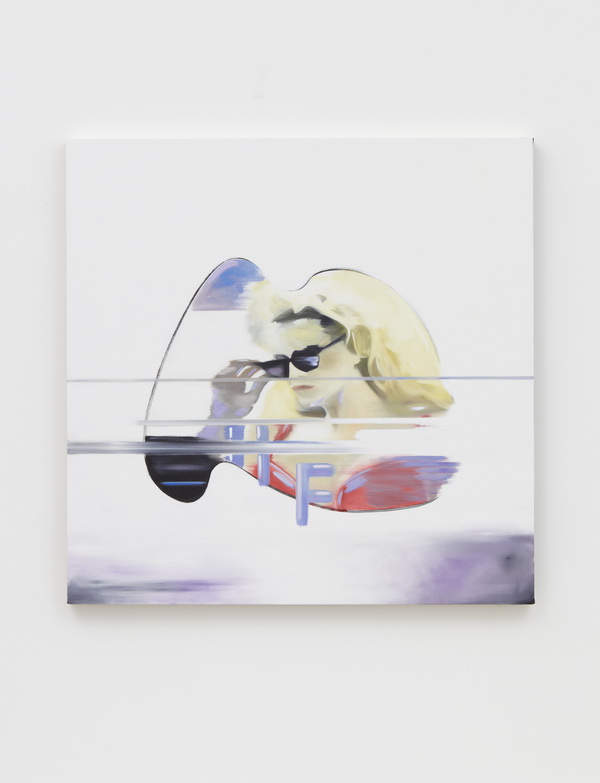Perhaps it is a bit cliché to read Julie Beaufils’ French nationality into her work, but there is certainly something undeniably chic, irreverent and casually erotic about her work. Her new paintings and drawings at Overduin & Co. filter desire through cool detachment and obfuscation. Faces are blurred, shown only in part or from a distance; narrative is often disrupted and fragmented, with Beaufils seeming keen to deny us any gestalt.
The subject matter, more suggested than explicitly depicted, is that of media, particularly the frenetic, disjointed nature of mainstream video and audio and its pervasiveness in contemporary culture. Several paintings, such as Watching Busy People (all works 2016), feature large orbs representing compact discs, which, through the smearing of the gray paint, seem to whir and reverberate. Most include painted fragments of images culled from television shows and online videos, but they are divorced from context and meaning and are now only frozen moments, distorted and incorporeal. In The Heat, an icy blonde lowers her dark shades, and in Fabio’s Deep House, that former paradigm of masculinity holds a clunky 1990s cellphone to his ear, his expression inscrutable.

Julie Beaufils, Watching busy people, 2016. Courtesy of Overduin & Co.
These scenes are limned by undulating lines and give the impression they might fade away and be replaced by something else; this ephemerality is further suggested by the pale colors and soft, almost insubstantial quality of the paint. In The Best Kim, the top of a young woman’s face is covered by an oppressive swath of monochromatic gray paint, almost resembling a fuzzy screen from an old television set; all that is left is her artificial Cheshire Cat grin.
Repeating visual motifs of apertures, cutouts and insets reinforces our role as spectators, and by muting and distancing the objects of the viewer’s desire, Beaufils offers a commentary on media’s tendency to make even sex consumable and impersonal.
The paintings are accompanied by “Untitled,” 100 smaller drawings roughly the size and shape of vinyl records, complete with plastic slipcovers and placed in a display shelf. In a cheeky nod to art-as-commodity, viewers have to flip through them to see each cover. Rendered in black-and-white, they feature simple drawings and the occasional humorous or cynical text; examples include a phonograph with the words “Sex Sounds” barked out; “After the Revolution” accompanying an empty white square, and the words “There’s no wrong/ Pro Choice.” The swiftness with which one flips through these works, as well as their large number, correlates with the rapid sensory experience of watching television or skimming webpages.
We are all, Beaufils seems to say, flaneurs—not of city streets but of a digital world we do not even need to leave our homes to perambulate. This barrage on our senses of countless images and sounds disrupts, lulls and unmoors us, but Beaufils’ cool, almost blasé works are more ambivalent than critical; this is our reality, and it might just be more pleasurable to surrender to the void.


